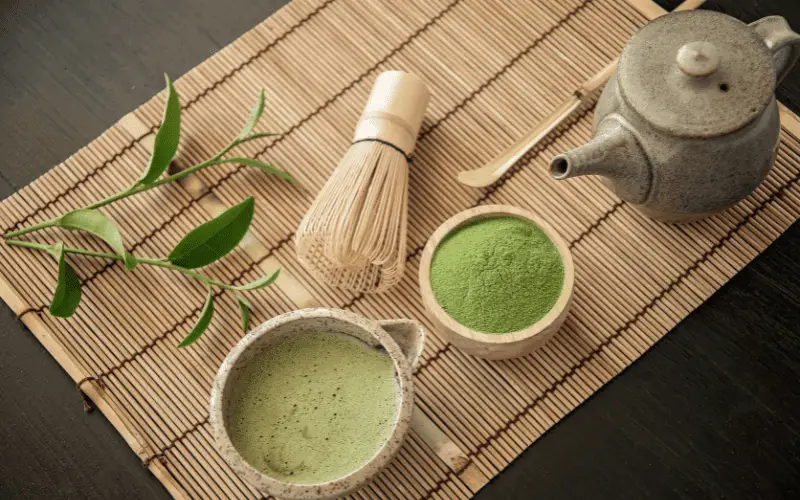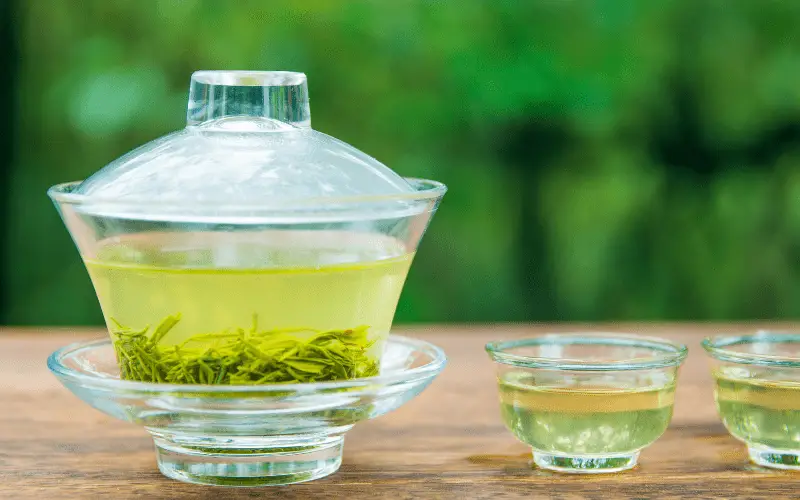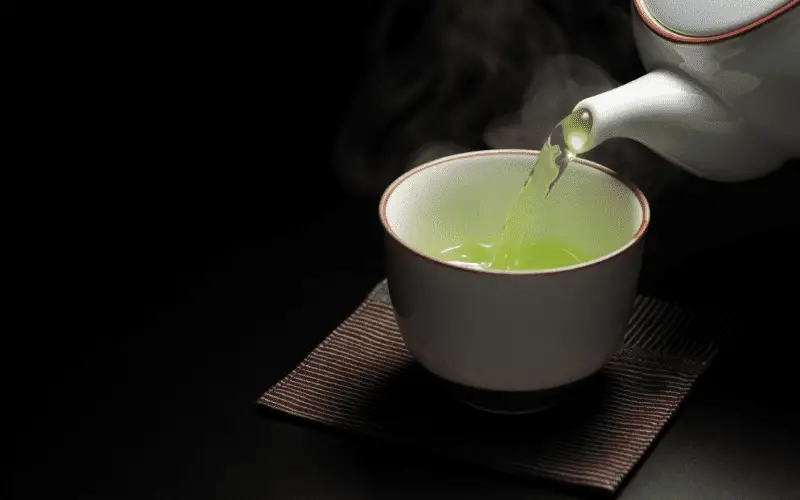Japanese green teas are renowned for their unique flavor profiles and health benefits. Among the most popular types of Japanese green teas are Sencha and Matcha. Whether you’re a tea enthusiast or simply looking to try something new, it’s important to understand the differences between these two teas. In this blog post, we’ll dive into the world of Sencha and Matcha and uncover the key differences between these two popular Japanese green teas.
Sencha is made from whole tea leaves that have been steamed and rolled, resulting in a more grassy and astringent taste, while Matcha is made from shade-grown tea leaves that are ground into a fine powder, resulting in a sweeter, smoother flavor. Matcha has a higher concentration of antioxidants, specifically EGCG, compared to Sencha due to the increased amount of chlorophyll produced in the shade-growing process. Matcha is commonly used in traditional Japanese tea ceremonies and in cooking, while Sencha is the most commonly consumed tea in Japan and can be found in both loose-leaf and tea bag form.
So, whether you prefer your tea in a loose-leaf form or in a tea bag, this guide will help you understand the differences between Sencha and Matcha, and ultimately choose the tea that’s right for you.
Origin And History Of Sencha and Matcha
Sencha and matcha are two of the most popular types of Japanese green teas, and they both have a rich history dating back centuries.
Sencha has been consumed in Japan for over 200 years and is the most popular form of green tea in the country. It was originally produced as a less expensive alternative to the high-grade gyokuro tea, which was reserved for the Japanese aristocracy. Today, sencha is enjoyed by tea drinkers around the world for its grassy aroma and pungent aftertaste.
Matcha, on the other hand, has its roots in the Japanese tea ceremony, which dates back to the 17th century. In this ceremony, matcha was prepared using a bamboo whisk to mix the powdered tea with hot water, creating a frothy, green drink. The tea ceremony was a revered tradition in Japan and was a symbol of cultural pride. Today, matcha is popular not only for its cultural significance but also for its health benefits and unique flavor profile.
Both sencha and matcha come from the same plant species, Camellia sinensis, and both are considered types of green tea. However, the methods of production and preparation, as well as the flavor profile and health benefits, are what set these two types of tea apart from each other.
The Differences In Production
Sencha and matcha are both made from the leaves of the Camellia sinensis plant, but their production methods differ in several key ways.
Sencha production involves steaming the freshly picked green tea leaves and then rolling and drying them. This process stops the oxidation process, preserving the bright green color and fresh flavor of the tea. The resulting tea can be found in loose-leaf form or in tea bags, making it a versatile option for tea drinkers.
Matcha production, on the other hand, is a more complex process. The tea leaves are grown in the shade for several weeks before they are harvested. This lack of direct sunlight increases the amount of chlorophyll in the leaves, giving matcha its deep green color. After being harvested, the tea leaves are dried and ground into a fine powder. The final product is a bright green powder that can be whisked into hot water to make a tea with a frothy, creamy texture.
One of the key differences between sencha and matcha is the fact that with matcha, you are consuming the entire leaf, not just the steeped water. This means that matcha contains more amino acids, antioxidants, and nutrients than sencha. Additionally, matcha contains a higher concentration of caffeine, making it a popular choice for a quick pick-me-up.
In terms of flavor, the deep steaming process used in sencha production gives the tea a grassy aroma and a pungent aftertaste, while the shading used in matcha production gives it a sweeter taste and a more complex flavor profile. The end result is two distinct types of tea with unique taste and health benefits, each with its own following of dedicated fans.

Nutritional Differences Between Sencha And Matcha
When it comes to the health benefits of tea, both sencha and matcha have a lot to offer. As two of the most popular types of Japanese green teas, they have a lot in common. However, there are some important differences to consider when it comes to the nutritional value of these two teas.
Sencha tea is made from the whole tea leaves of the Camellia sinensis plant, which contains a high amount of chlorophyll and antioxidants. This tea also contains amino acids and has been shown to help with weight loss and reducing the risk of heart disease.
Matcha, on the other hand, is made from a fine powder form of green tea leaves that are shade-grown before harvest. This process increases the amount of chlorophyll, making matcha a particularly rich source of antioxidants. Matcha also contains the highest levels of epigallocatechin gallate (EGCG), a type of catechin that has been shown to have a number of health benefits.
One key difference between sencha and matcha is that matcha is consumed in a powdered form. This means that when you drink a cup of matcha, you are consuming the entire tea leaf, which provides a more concentrated source of nutrients than sencha. Additionally, because matcha is made from shade-grown tea leaves, it has a higher caffeine content than sencha.
Ultimately, both sencha and matcha offer unique nutritional benefits and can be enjoyed as part of a healthy diet. Whether you prefer the pungent aftertaste of sencha or the sweeter taste of matcha, both teas provide a variety of health benefits that make them a great choice for tea enthusiasts.
The Differences In Flavor Profile:
When it comes to flavor profile, there are several differences between sencha and matcha tea. Sencha has a grassy aroma and a pungent aftertaste that is distinct from matcha, which has a more complex flavor profile. The latter has an umami flavor and a natural sweetness, due to the absence of sunlight during the growth process, which makes the tea plant produce more amino acids. Additionally, the absence of direct sunlight also contributes to matcha’s deep green color and high amount of chlorophyll.
In terms of taste, sencha can be described as a mild, delicate and slightly bitter tea, while matcha is usually described as having a smooth, creamy and slightly sweet taste. This can be attributed to the fact that matcha is made from a fine powder, while sencha is a loose-leaf tea. The production process of matcha also allows for a greater concentration of tea flavor, making it a sweeter tea than sencha.
It’s worth noting that the tea plants used to produce both matcha and sencha tea come from the same plant species – Camellia Sinensis. The only difference is that matcha tea plants are grown under shade to produce a sweeter, smoother and more vibrant tea, while sencha tea plants are grown in full sunlight.

Popular Uses Of Sencha And Matcha
Sencha and Matcha, two of the most popular types of Japanese green teas, are enjoyed in different ways by tea enthusiasts all over the world. Although they are both made from Camellia sinensis, the same plant species, they offer different flavor profiles and nutritional benefits that make them ideal for different applications.
One of the most popular uses for Sencha tea is as a loose-leaf tea, where the whole tea leaves are steeped in hot water to produce a pungent, grassy aroma and a bright green color. Many tea drinkers enjoy Sencha for its health benefits, including its high levels of amino acids and antioxidants that can help fight free radicals and prevent heart disease.
Matcha, on the other hand, is best known for its bright green powder form. This fine powder is made from shade-grown tea leaves, which are then ground into a fine powder and whisked with hot water to create a smooth, frothy, and sweet-tasting tea. Matcha is also used in many other applications, such as in baking, cooking, and even in ice cream, due to its unique and complex flavor profile.
One of the key differences between Sencha and Matcha is the amount of chlorophyll they contain. Matcha has a higher amount of chlorophyll due to the way it is produced, which results in a deeper green color and a sweeter tea with less caffeine than regular green tea. In contrast, Sencha is a more pungent tea with a grassy aroma and a brighter green color, due to its exposure to direct sunlight during production.
The major differences between Sencha and Matcha don’t just stop at their flavor profiles and nutritional benefits. Matcha is also made from the whole tea leaf, which means that it retains more of the tea plant’s nutrients and benefits, such as its high levels of antioxidants and low levels of caffeine. Sencha, on the other hand, is made from whole tea leaves that are steamed, which results in a different type of tea with its own unique set of benefits and flavor profile.
Conclusion
In conclusion, sencha and matcha are both Japanese green teas with a rich history and tradition behind them. While they both come from the same Camellia sinensis plant species, the differences in production and processing lead to distinct flavor profiles and nutritional differences. Sencha has a grassy aroma with a pungent aftertaste, while matcha boasts a more complex flavor profile with a natural sweetness and umami flavor. In terms of health benefits, both teas contain antioxidants and amino acids that can protect against free radicals and promote weight loss, however matcha has higher levels of epigallocatechin gallate and less caffeine. Sencha is often enjoyed in its loose-leaf form and can be brewed as a hot or cold tea, while matcha is traditionally enjoyed as a fine powder that is whisked with hot water to create a vibrant green tea. Regardless of which type of tea you choose, both sencha and matcha are excellent choices for anyone looking to incorporate more whole tea leaves and green tea plants into their diet.
Indulge in a sip of tea knowledge and discover the fascinating contrast between ceremonial and culinary matcha with this must-read article.

